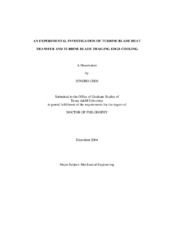An experimental investigation of turbine blade heat transfer and turbine blade trailing edge cooling
Abstract
This experimental study contains two points; part1 – turbine blade heat transfer
under low Reynolds number flow conditions, and part 2 – trailing edge cooling and
heat transfer. The effect of unsteady wake and free stream turbulence on heat transfer
and pressure coefficients of a turbine blade was investigated in low Reynolds number
flows. The experiments were performed on a five blade linear cascade in a low speed
wind tunnel. A spoked wheel type wake generator and two different turbulence grids
were employed to generate different levels of the Strouhal number and turbulence
intensity, respectively. The cascade inlet Reynolds number based on blade chord
length was varied from 15,700 to 105,000, and the Strouhal number was varied from 0
to 2.96 by changing the rotating wake passing frequency (rod speed) and cascade inlet
velocity. A thin foil thermocouple instrumented blade was used to determine the
surface heat transfer coefficient.
A liquid crystal technique based on hue value detection was used to measure
the heat transfer coefficient on a trailing edge film cooling model and internal model of
a gas turbine blade. It was also used to determine the film effectiveness on the trailing
edge. For the internal model, Reynolds numbers based on the hydraulic diameter of
the exit slot and exit velocity were 5,000, 10,000, 20,000, and 30,000 and
corresponding coolant – to – mainstream velocity ratios were 0.3, 0.6, 1.2, and 1.8 for
the external models, respectively. The experiments were performed at two different
designs and each design has several different models such as staggered / inline exit,
straight / tapered entrance, and smooth / rib entrance. The compressed air was used in
coolant air. A circular turbulence grid was employed to upstream in the wind tunnel
and square ribs were employed in the inlet chamber to generate turbulence intensity
externally and internally, respectively.
Citation
Choi, Jungho (2004). An experimental investigation of turbine blade heat transfer and turbine blade trailing edge cooling. Doctoral dissertation, Texas A&M University. Texas A&M University. Available electronically from https : / /hdl .handle .net /1969 .1 /1377.


